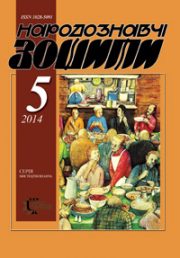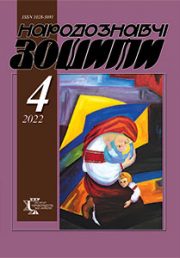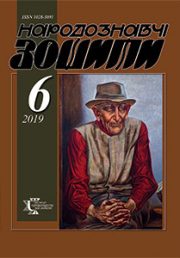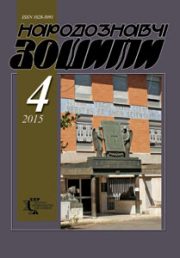The Ethnology Notebooks. 2019, № 5 (149), 1123—1133
UDK 398 (477.82) + 392(477.82)
DOI https://doi.org/10.15407/nz2019.05.1123
THE CULTURE AND TRADITIONS OF RESIDENTS OF LAKES OF SHATSK IN FOLK TOPONIMIC PROSE
SHKLYAYEVA Natalia
ORCID ID: https://orcid.org/0000-0003-1324-8841
Candidate of Philology, Associate Professor
Department of Ukrainian and Foreign Linguistics
Lutsk National Technical University
75, Lvivska~ str., 43000, Lutsk, Ukraine
e-mail: metrolog97@gmail.com
Abstract. The article talk about toponymic prose as most numerous and the section of Ukrainian folk creation that is least studied. This area of folk-lore belongs to the most impressionable spheres, as makes one of the most dynamic phenomenon of folk creation. Actuality of the article is devoted to history and problems of research of folk toponymic prose of lakes of Shatsk.
Problem Statement. The article talk about the genre features of folk toponymic prose of lakes of Shatsk. Folk toponymic prose appears as the name, which engulfs large and various after the thematic filling folk-lore thematically genre array, which touches the sphere of folk knowledges, presentations and beliefs and functions in the form of translations, legends the basic setting of which to explain place-name, is conditional.
Purpose. The study of multifunctionality of toponymic prose in a combination of plots, motifs and themes from historical ethnographic and geographic-biological data, analysis of the toponymic prose of Shatsk suspicion on the mesoponimic and microtoponimic level.
Methods. For effect in achieving the result you must apply historical, comparative, historical-geographical, statistical methods.
The object of the study is toponymic retellings and legends with the toponymic motives of the Shatsk lake.
Results. The distinction between genre varieties of toponymic prose is specified; trace the interrelations of folk and scientific information, investigate what specific historical, social, geographical factors influenced the creation of toponymic prose of various subjects; It is traced according to the specifics of concentration of certain basic motivations in different regions of Shatsk.
Lakes of Shatsk antroponymic system has close connection with social phenomenon. It includes not only people names, family names and nick-names, but also age, time and social characteristics. Writings, in which family everyday motives is the basis, refer to theme of love and matrimony relations. More often the legends belong to them and, usually, with tragedy content.
It is also told about reasons of agriculture, cattle breeding and most widespread folk trades in folk toponymic prose of lakes of Shatsk. Such reasons prevail in this region. They are traced the most ancient times and to beginning of XX age. In the article told about reasons of hunt and fishing in folk toponymy prose of lakes of Shatsk which is most widespread and oldest among economic reasons of region.
Conclusion. Thus, on the basis of samples of the popular toponymic prose of Shatsk, we find out that the basis of the economic activity of the population of the region, except dominant hunting and fishing as the most ancient branches of the national economy and livestock and agriculture, — classes of occupations that arose in the process of development of natural conditions, were also ancient crafts — forging, furry, transportation, mining of clay and peat, etc. In the popular toponymic prose, there were references to the development of enterprises for the processing of agricultural products, wood chimneys, and brick making enterprises.
Keywords: lakes of Shatsk ,Western Polisya, folk toponymic prose, reason, translation, family connections, legends, tragedy content, place-name, Ukrainian folk creation, folk knowledges, of translations.
Received 7.08.2019
REFERENCES
Davydyuk, V.F., & Arkushin, G. (1991). Polissya House. Folklore and linguistics collection. Lutsk: Editorial and publishing department of the Volyn Regional Press Office [in Ukrainian].
Kirchov, R.F. (1996). Folklore of Ukrainian Polissya. Drevlyany, 1. Lviv [in Ukrainian].
Kraszewski, I.L. (1930). Wspomnienia Woіyn, Polesia i Litwy. W-wa [in Polish].
Niezbrzycki, l. (1985). Polesie: opis wojskowo-geograficzny i studium terenu. W-wa [in Polish].
Steski, T.L. Woіyс under the influence of the statue, history and archeologists (Vol. 1) [in Polish].
6.Travel Kontryma official Polish bank, finishing in the year 1829 to Polesie. (1839). Poznaс [in Polish].
Davydyuk, V. (Ed.). (1993). Legends of Polissya. Lutsk: Superstitions [in Ukrainian].
Davydyuk, V. (Ed.). (1996). Gold chest. Lutsk [in Ukrainian].
Galician-Volyn chronicle. (1994). Lviv: Chervona Kalina [in Ukrainian].
Kyrychuk, M.G. (1995). Volyn-Ukrainian land. Lutsk: Superstition [in Ukrainian].
Archive of the FVNC. F. 1. Unit. vol. 114. P. 1 [in Ukrainian].
Recorded by Larisa Bondar in the village Zhorana Lyubomlsky district from Maria Vedents, 1924 AD.
Falcon, V. (1995). Folk legends and translations of Ukrainian Carpathians. Kiev: Scientific Opinion [in Ukrainian].
Archive of the FVNC. F. 1. Unit 76. Ark. 1 [in Ukrainian].
Archive of the FVNC. F. 1B. Op. p. 30. P. 1 [in Ukrainian].
Archive of the FVNC. F. 1. Unit save 118. Arch. 1 [in Ukrainian].
Archive of the PWNC. F. 1A. Op. save 39. Ark. 1 [in Ukrainian].
Zheleznyak, I.M. (Ed.). (1999). Onomastics of Polissya. Kiev [in Ukrainian].
Grushevsky, M.S. (1992). History of Ukraine-Rus (Vol. 5). Kyiv [in Ukrainian].
Kostomarov, M.I. (1994). Slavic mythology. Kyiv: Lybid [in Ukrainian].
Bulashev, G.O. (1993). The Ukrainian people in their legends, religious beliefs and beliefs. Kyiv: Trust [in Ukrainian].
Tkachuk, P. (1999). National composition of the population of Volyn (1897—1989 pp.). National Minorities of the Right-Bank Ukraine: History and Modernity (Pp. 31—35). Zhytomyr [in Ukrainian].
Archive of the PWNC. F. 1A. Op. sv. 51. Ark. 1 [in Ukrainian].
Nulko, V.I. (1996). Ethnic composition of the population of the Ukrainian SSR. Kyiv: Naukova dumka [in Ukrainian].
Bagmet, M. (1994). The problem of coverage of German settlements in Volyn. Volyn and Volyn foreign countries (P. 120). Lutsk [in Ukrainian].
The archive of the Pvnc. F. 5. Od. zb. 3. Ark. 1 [in Ukrainian].
Supernanskaya, A.V. (1984). What is toponymy. Moscow: Science [in Russian].
Shutova, N.M. (1996). Anthroponomics and social context. Problems of English Contextology, 3, 131—135 [in Russian].
Archive of the PWNC. F. 1A. Op. save 35. Arc. 1 [in Ukrainian]
Archive of the PNVC. F. 1. Op. tab. 108. Ark. 1 [in Ukrainian].
The archive of the PVNC. F. 1A. Op. save 69. Ark. 1 [in Ukrainian]
The archive of the PVNC. F. 1A. Op. save 67. Ark. 1 [in Ukrainian]
Poida, D.P. (1960). Peasant movement on the Right-Bank Ukraine in post-reform period. Dnipropetrovsk [in Russian].
Daniluk, A. (1993). Our Hut: An Ethnographic Essay on Traditional Police Housing. Lutsk: Supermarket [in Ukrainian].
Archive of the PWNC. F. 1. Od. ab. 119a. Ark. 1 [in Ukrainian].
Klimchuk, B.P., Lutsyshina, P.V., & Lazhnaya, Ya. (Eds.). (1997). Euroregion Bug: Volyn region. Lutsk: Red.-view. away Volyn Un-th [in Ukrainian].
Archive of the PWNC. F. 1. Unit save 119. Ark. 1 [in Ukrainian].
Archive of the PWNC. F. 1B. Op. save 56. Arc. 1 [in Ukrainian]
Archive of the PVNC. F. 1. Unit save 25. Ark. 1 [in Ukrainian].
Archive of the PVNC. F. 1A. Op. save 29. Arc. 1 [in Ukrainian].
Archive of the PVNS. F 1B. Op. save 63. Ark. 1 [in Ukrainian].
Archive of the PVNS. F 1. O. zb. 115a. Ark. 1 [in Ukrainian].







